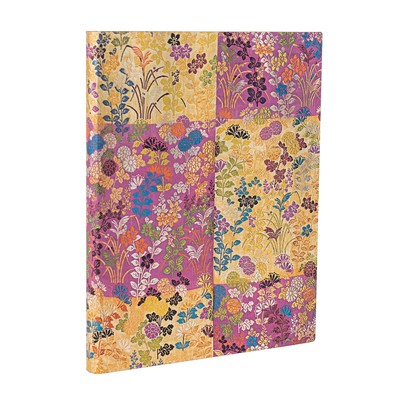
- Išsiųsime per 10–14 d.d.
- Leidėjas: PAPERBLANKS
- ISBN-10: 1439798168
- ISBN-13: 9781439798164
- Formatas: 17.5 x 23.6 x 1.5 cm, minkšti viršeliai
- Kalba: Anglų
- Extra -15 % nuolaida šiai knygai su kodu: ENG15
Japanese Kimono Kara-Ori Pink Softcover Flexi Ultra Unl (el. knyga) (skaityta knyga) | knygos.lt
Atsiliepimai
Aprašymas
Showcasing silk dyed with beni (the pigment extracted from safflower petals) and lacquered in gold, this kimono design dates to the Edo period (1615-1868). It was originally used as a costume for the theatrical style known as Noh. Karaori refers specifically to the exquisitely embroidered woman's kimono that traditional Noh theatre was known for. Both the material itself and the pattern depicted would have helped tell the story of the character. In this case, the stiff brocade creates a thick, glossed fabric that would not drape easily - this created an angular effect evoking the spirit of a noblewoman. The pattern of flowering grasses emphasized the character's femininity. By the Meiji period (1868-1912) Noh had reached such heights that it was widely introduced overseas, and today there are still more than 70 Noh theatres throughout Japan. This beautiful example of karaori costuming can now be found at the Art Institute of Chicago. It is our great pleasure to work with such a gorgeous and culturally important piece of history to craft this journal design.
EXTRA 15 % nuolaida su kodu: ENG15
Akcija baigiasi už 5d.02:48:32
Nuolaidos kodas galioja perkant nuo 10 €. Nuolaidos nesumuojamos.

- Leidėjas: PAPERBLANKS
- ISBN-10: 1439798168
- ISBN-13: 9781439798164
- Formatas: 17.5 x 23.6 x 1.5 cm, minkšti viršeliai
- Kalba: Anglų Anglų
Showcasing silk dyed with beni (the pigment extracted from safflower petals) and lacquered in gold, this kimono design dates to the Edo period (1615-1868). It was originally used as a costume for the theatrical style known as Noh. Karaori refers specifically to the exquisitely embroidered woman's kimono that traditional Noh theatre was known for. Both the material itself and the pattern depicted would have helped tell the story of the character. In this case, the stiff brocade creates a thick, glossed fabric that would not drape easily - this created an angular effect evoking the spirit of a noblewoman. The pattern of flowering grasses emphasized the character's femininity. By the Meiji period (1868-1912) Noh had reached such heights that it was widely introduced overseas, and today there are still more than 70 Noh theatres throughout Japan. This beautiful example of karaori costuming can now be found at the Art Institute of Chicago. It is our great pleasure to work with such a gorgeous and culturally important piece of history to craft this journal design.


Atsiliepimai